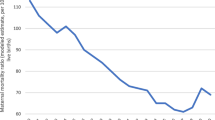Abstract
In the last 30 years the health status of black women has improved. However, the likelihood of health problems from complications of pregnancy and childbirth or prolonged illness from combined effects of diabetes, hypertension, and obesity remains. The need for continuity of care for these conditions and the low economic status of black women suggest that current policy shifts away from emphasis on increased access to medical care will adversely affect the health status of black women. Policies to contain health-care costs should therefore be designed to assure appropriate access to needed care for black women and other low-income groups.
Similar content being viewed by others
Notes
U.S. Department of Commerce, Bureau of the Census,Estimates of the Population of the United States by Age, Sex, and Race: 1980 to 1984 (Current Population Reports. Population Estimates and Projections), Series P-25, no. 965 (Washington, D.C.: Bureau of Census, March 1985), Table 1, p. 9.
U.S. Department of Commerce, Bureau of the Census,Money Income of Households, Families, and Persons in the United States: 1981 (Current Population Reports, Consumer Income), Series P-60, no. 137 (Washington, D.C.: Bureau of the Census, March 1983), Table 13, pp. 32–34.
Center for National Policy, American Medical Association,The Environment of Medicine, Report of the Council on Long Range Planning and Development (Chicago: American Medical Association, 1983 and 1985).
U.S. Department of Health and Human Services, Public Health Service,Health, United States, 1984 (Hyattsville, Md.: National Center for Health Statistics, December 1984), Table 11, p. 53.
Health, United States, 1984, Table 16, pp. 59–60, and American Cancer Society,Cancer Facts and Figures for Minority Americans, 1983 (New York: American Cancer Society, 1983).
Health, United States, 1984, Table 12, p. 54; Table 25, p. 76.
Health, United States, 1984, Table 25, p. 76.
U.S. Department of Health and Human Services, National Center for Health Statistics,Trends in Teenage Childhearing, United States 1970-81, Series 21, no. 41, Table 4, p. 17.
U.S. Department of Health, Education, and Welflare, National Center for Health Statistics,Vital and Health Statistics: Factors Associated with Low Birth Weight, United States, 1976, Series 21, no. 37, p. 2.
Factors Associated with Low Birth Weight, United States, 1976, Table 4, p. 27;Trends in Teenage Childbearing, United States, 1970-81, Table 9, p. 20.
Factors Associated with Low Brith Weight, Table 4.
Diabetes Mellitus (Indiana: Eli Lilly and Company, 1980), p. 179.
The Carter Center of Emory University, “Closing the Gap: The Problem of Diabetes Mellitus in the United States,”Diabetes Care, 8, no. 4 (July–August 1985): 391–406.
Health, United States, 1984, Table 39, p. 94; Carter Center, “Closing the Gap: The Problem of Diabetes Mellitus in the United States,” p. 391.
Terence Wilson, “Weight Control Treatments,” InBehavioral Health, Joseph Matarazzo et al., eds. (New York: John Wiley & Sons, 1984), pp. 657–670; George Bray, “The Role of Weight Control in Health Promotion and Disease Prevention,” inBehavvioral Health, pp. 632–656.
Wilson, “Weight Control Treatments,” p. 634; James Alexander, “Blood Pressure and Obesity,” InBehavioral Health, pp. 877–888.
Karen Davis and Dianne Rowland, “Uninsured and Underserved: Inequalities in Health Care in the United States,”Milbank Memorial Fund Quarterly: Health and Society 61, no. 2 (Spring 1983): 149–176.
Center for National Policy,Health Care: How to Improve It and Pay for It (Washington, D.C.: Center for National Policy, April 1985), p. 1. This book contains articles by Lynn Etheredge, Uwe Reinhardt, Theodore R. Marmor and Andrew Dunham, Karen Davis, and David Blumenthal, and an introduction by Ben W. Heineman, Jr. A conclusion of this panel of prominent researchers convened by the Center for National Policy is that “current health finance policy in the United States will not stop the rise in medical care costs, and more people will be left out of the system as pressures of competition increase” (p. 1). Also see Karen Davis, “Access to Health Care: A Matter of Fairness,” inHealth Care: How to Improve It and Pay for It Series Alternatives for the 1980’s, no. 17, (Washington, D.C.: Center for National Policy, 1985), pp. 45–57.
Jack Hadley,More Medical Care, Better Health?: An Economic Analysis of Mortality Rates (Washington, D.C.: The Urban Institute Press, 1982), Table 11, p. 62.
Health, United States, 1984, Table 41. p. 97.
Health, United Slates, 1984, Table 51, p. 109.
Health, United Stales, 1984, Table 51. p. 109.
Health, United States, 1984, Table 42, p. 971.
Joseph P. Newhouse, et al.,Some Interim Results from a Controlled Trial of Cost Sharing in Health Insurance (Santa Monica, California: Rand Corporation, 1982).
Nicole Lurie, Nancy Ward, Martin Shapiro, and Robert Brook, “Termination From Medi-Cal: Does it Affect Health?”New England Journal of Medicine 311. no. 7 (August 16, 1984): 480–484.
About this article
Cite this article
Headen, A.E., Headen, S.W. General health conditions and medical insurance issues concerning black women. The Review of Black Political Economy 14, 183–197 (1985). https://doi.org/10.1007/BF02689886
Issue Date:
DOI: https://doi.org/10.1007/BF02689886




